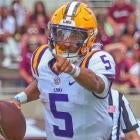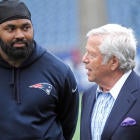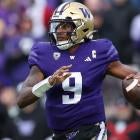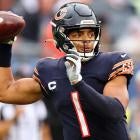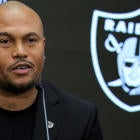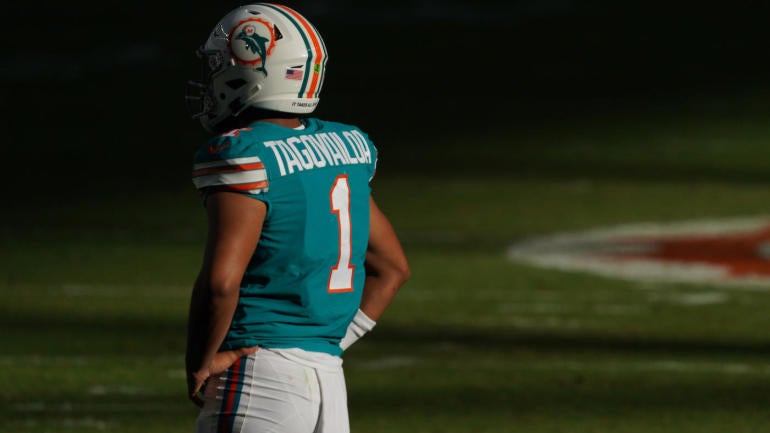
The Miami Dolphins on Friday made the first big moves of draft season, trading out of the No. 3 overall pick, which they sent to the San Francisco 49ers in exchange for the No. 12 pick in this year's draft, plus the 49ers' first- and third-round selections in 2022 and their first-round pick in 2023. The Dolphins then turned right around and sent No. 12 and No. 123 to the Philadelphia Eagles, along with their own 2022 first, in exchange for the No. 6 and No. 156 selections.
Add it all up and the series of deals looks like this:
| Team | Trades | Receives |
| MIA | 3, 123, 2022 1st | 6, 156, 2022 1st (SF), 2022 3rd (SF), 2023 1st (SF) |
| SF | 12, 2022 1st, 2022 3rd, 2023 1st | 3 |
| PHI | 6, 156 | 12, 123, 2022 1st (MIA) |
In essence, the Dolphins moved down three picks in the first round and 33 picks on Day 3, and in exchange, agreed to swap their own first-round pick in 2022 for San Francisco's, while also receiving the 49ers' third-round pick in 2022 and their first-round pick in 2023.
How one values the haul the Dolphins received depends on several things (including which players get picked at which spots, obviously), but one objective way to measure it is to use one of the many available draft value charts to gauge the value of the picks themselves. As an all-draft-pick series of trades, that seems like a wise way to go.
Craving even more NFL coverage focusing on previews, recaps, news and analysis? Listen below and follow the Pick Six podcast for a daily dose of everything you need to follow pro football.
To do this, we used four different draft charts: the Fitzgerald-Spielberger chart at overthecap.com, which "uses NFL salary data to retroactively grade every draft selection from 2011 through 2015 following the conclusion of their rookie contracts, and to use that data to better project the value of each future draft selection"; the Jimmy Johnson chart, which was popularized by the 1990s Dallas Cowboys and has been used by a wide variety of NFL teams over the years; the Chase Stuart chart at FootballPerspective.com, which uses Pro-Football-Reference's Approximate Value to estimate the impact of draft picks through their first five NFL seasons; and the chart created by CBSSports.com editor R.J. White, which uses actual draft-pick trades made over the past five years to account for their value.
On the Johnson chart, the Dolphins came out losers, surrendering the equivalent of the No. 98 overall pick in terms of value. But on the more modern charts, the Dolphins came out ahead, though the degree to which they did depends on which valuation method you prefer.
| Chart | Dolphins Gain | Pick Equivalent |
| Fitzgerald-Spielberger | 1234 | 33 |
| Jimmy Johnson | -109.6 | -98 |
| Chase Stuart | 9.0 | 56 |
| RJ White | 5.1 | 185 |
Judging by their moves over the past two offseasons, it seems fairly clear that the Dolphins find pick volume to be just as, if not more valuable than pick quality. They moved down three spots in the first round here, but they also turned three draft picks into five, netting themselves extra selections in the 2022 third round and 2023 first round. Having already made 11 selections (including three first-rounders) in last year's draft, the Dolphins now have eight picks this year, including four of the first 50 overall. They have at least two extra picks coming their way in 2022 (a third and a seventh), and an additional first in 2023.
And they already have a roster that made a dramatic improvement from 2019 to 2020, jumping from 5-11 to 10-6 and narrowly missing out on the playoffs. Miami has been unafraid to spend in free agency, utilizing its boatloads of cap space to land contributors on both sides of the ball while also maintaining enough flexibility to pivot to a new plan if it so chooses. There is still plenty of work to be done, but stockpiling both picks and cap room allows the Dolphins to fill the holes in their roster any way they want.
They can sign Byron Jones and draft Noah Igbinoghene, then sign Justin Coleman, too. They can draft Austin Jackson and Robert Hunt and then take a delayed flier on Isaiah Wilson, then cut Wilson when it becomes clear nothing will come of that. They can sign Ereck Flowers and then use a mid-round pick on Solomon Kindley. They can sign Ted Karras to give them a solid center, let him leave a year later, then replace him with Matt Skura to do the same. They can sign Will Fuller on a discount deal, then move down in the draft, only to move right back up into a range where they should probably still get the best wide receiver on the board and pair him with Tua Tagovailoa over the longer term. They can do all of that and still have plenty of room under the cap (approximately $50 million next offseason, at the moment) and plenty of additional draft capital to acquire more foundational players.
Perhaps unsurprisingly given that general manager Chris Grier and head coach Brian Flores came to Miami from New England, it's a very Patriots-esque way of doing business. The goal is to build a deep, versatile roster that can contend for years to come. The path to get there is staying flexible and allowing yourself multiple avenues to putting the best team around your quarterback that you possibly can.
The Dolphins placed a bet that Tagovailoa can elevate this version of the roster, but they also gave themselves an out in 2023 if that doesn't work. It's probably not a coincidence that the year the Dolphins have another two firsts is the one where Tagovailoa becomes extension-eligible. If they're not prepared to give him a long-term deal, they can send him elsewhere, while also moving their two early picks to find the next guy they want under center. In the meantime, they can make sure that whomever the long-term answer is, he's surrounded by a wealth of talent that can put him in position to succeed.














